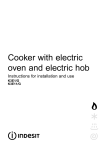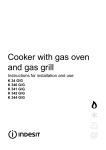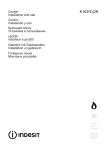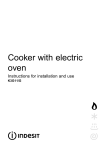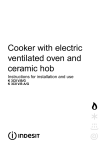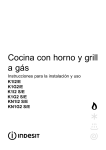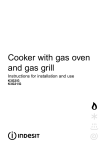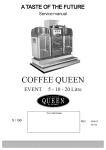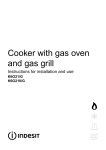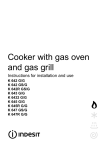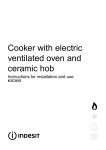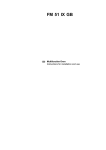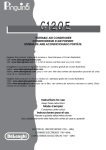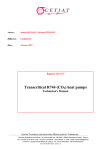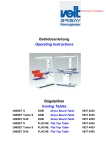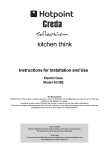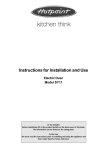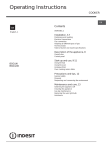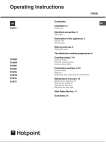Download Hotpoint C120E User's Manual
Transcript
kitchen think Instructions for Installation and Use Cooker with electric oven and electric hob Model C120E To the Installer Before installation fill in the product details on the back cover this book. The information can be found on the rating plate. To the User You must read the instructions prior to installing and using the appliance and then retain them for future reference. CONTENTS INTRODUCTION ..................................................................................... 3 IMPORTANT SAFETY WARNINGS ........................................................ 4 INSTALLATION ....................................................................................... 5 TECHNICAL SPECIFICATIONS ............................................................. 6 THE COOKER WITH ELECTRIC OVEN AND ELECTRIC HOB ............ 7 THE DIFFERENT FUNCTIONS AND USES OF THE OVEN ............... 8-9 COOKING ADVICE .......................................................................... 10-11 COOKER ROUTINE MAINTENANCE AND CLEANING...................... 12 THE CATALYTIC SELF-CLEANING SYSTEM ..................................... 13 KEY CONTACTS................................................................................... 16 Retention of this Instruction Book This Instruction Book must be kept handy for reference as it contains important details on the safe and proper use of the appliance. If you sell or pass the appliance to someone else, or move house and leave it behind, make sure this Book is also provided so the new owner can become familiar with the appliance and safety warnings. If the Book is lost or damaged a copy may be obtained from: Indesit Company UK LTD., Morley Way, Peterborough, PE2 9JB 2 Introduction Your new electric oven is guaranteed* and will give lasting service. This guarantee is only applicable if the appliance has been installed in accordance with the installation instructions detailed in this booklet. To help make best use of your cooking equipment, please read this booklet carefully. The oven is designed specifically for domestic use and responsibility will not be accepted for use in any other installation. Note: When the oven is first used, an odour may be omitted - this will cease after a short period of use. To help remove the 'new' smell, heat the empty oven to maximum temperature for a minimum of two to three hours, keeping the door/s closed. Ensure that the room is well ventilated (eg. open a window or use an extractor fan) and that persons who may be sensitive to the odour avoid any fumes. It is suggested that any pets be removed from the room until the smell has ceased. This odour is due to any temporary finish on oven linings and elements and any moisture absorbed by the insulation. * The guarantee is subject to the provisions that the appliance: (a) Has been used solely in accordance with this booklet. (b) Has been properly connected to a suitable supply voltage as stated on the rating plate, attached to the appliance. (c) Has not been subjected to misuse or accident or been modified or repaired by any person other than the manufacturers authorised employee or agent. (d) Has been correctly installed. 3 Important safety warnings To maintain the EFFICIENCY and SAFETY of this appliance, we recommend: • call only the Service Centers authorized by the manufacturer • always use original Spare Parts 1 This appliance is intended for nonprofessional use within the home. 2 These instructions are only for those countries whose symbols appear in the booklet and on the serial no. plate of the appliance. 3 This owner’s manual is for a class 1 appliance (insulated) or class 2, subclass 1 appliances (installed between two cabinets. 4 Before using your appliance, read the instructions in this owner’s manual carefully since it provides all the information you need to ensure safe installation, use and maintenance. Always keep this owner’s manual close to hand since you may need to refer to it in the future. 5 When you have removed the packing, check that the appliance is not damaged. If you have any doubts, do not use the appliance and contact your nearest Ariston Service Centre. Never leave the packing components (plastic bags, polystyrene foam, nails, etc.) within the reach of children since they are a source of potential danger. 6 The appliance must be installed only by a qualified technician in compliance with the instructions provided. The manufacturer declines all liability for improper installation, which may result in personal injury and damage to property. 7 The electrical safety of this appliance can only be guaranteed if it is correctly and efficiently earthed, in compliance with regulations on electrical safety. Always ensure that the earthing is efficient. If you have any doubts, contact a qualified technician to check the system. The manufacturer declines all liability for damage resulting from a system which has not been earthed. 8 Before plugging the appliance into the mains, check that the specifications indicated on the date plate (on the appliance and/or packaging) correspond with those of the electrical and gas systems in your home. 9 Check that the electrical capacity of the system and sockets will support the maximum power of the appliance, as indicated on the data plate. If you have any doubts, contact a qualified technician. 10 An omnipolar switch with a contact opening of at least 3 mm or more is required for installation. 11 If the socket and appliance plug are not compatible, have the socket replaced with a suitable model by a qualified technician, who should also check that the cross-section of the socket cable is sufficient for the power absorbed by the appliance. The use of adaptors, multiple sockets and/or extensions, is not recommended. If their use cannot be avoided, remember to use only single or multiple adapters and extensions which comply with current safety regulations. In these cases, never exceed the maximum current capacity indicated on the individual adaptor or extension and the maximum power indicated on the multiple adapter. 12 Do not leave the appliance plugged in if it is not in use. Switch off the main switch and gas supply when you are not using the appliance. 13 The openings and slots used for ventilation and heat dispersion must never be covered. 14 The user must not replace the supply cable of this appliance. Always contact an after-sales service centre which has been authorised by the manufacturer if the cable has been damaged or needs replacement. 15 This appliance must be used for the purpose for which it was expressly designed. Any other use (e.g. heating rooms) is considered to be improper and consequently dangerous. The manufacturer declines all liability for damage resulting from improper and irresponsible use. 16 A number of fundamental rules must be followed when using electrical appliances. The following are of particular importance: • Do not touch the appliance when your hands or feet are wet. • Do not use the appliance barefooted. • Do not use extensions, but if they are necessary, caution must be exercised. • Never pull the power supply cable or the appliance to unplug the appliance plug from the mains. • Never leave the appliance exposed to atmospheric agents (rain, sun etc.) • Do not allow children or persons who are not familiar with the appliance to use it, without supervision. 17 Always unplug the appliance from the mains or switch off the main switch before cleaning or carrying out maintenance. 18 If you are no longer using an appliance of this type, remember to make it unserviceable by unplugging the appliance from the mains and cutting the supply cable. Also make all potentially dangerous parts of the appliance safe, above all for children who could play with the appliance. 19 To avoid accidental spillage do not use cookware with uneven or deformed bottoms on the electric plates. Turn the handles of pots and pans inwards to avoid knocking them over accidentally. 20 Never use flammable liquids such as alcohol or gasoline, etc. near the appliance when it is in use. 21 When using small electric appliances near the hob, keep the supply cord away from the hot parts. 22 Make sure the knobs are in the “•”/”¡” position when the appliance is not in use. 23 When the appliance is in use, the heating elements and some parts of the oven door become extremely hot. Make sure you don’t touch them and keep children well away. 24 If the cooker is placed on a pedestal, take the necessary precautions to prevent the same from sliding off the pedestal itself. 4 Installation The following instructions should be read by a qualified technician to ensure that the appliance is installed, regulated and technically serviced correctly in compliance with current regulations. Important: disconnect the cooker from the electricity when making any adjustement, maintenance operation, etc. N.B.: the following installation procedure must be carried out by a qualified electrician.The electrical installation must comply with the IEE Regulations, Building & local By-Lays. For the installation of the feeding cable carry out the following operations: l Unscrew screw “V” (see fig. A) l Pull and open the junction blok lid Important: the wires in the mains lead are coloured in accordance with the following code: Green & Yellow Earth Blue Neutral Brown Live As the colours of the wires in the mains lead may not correspond with the coloured markings identifying the terminals in your plug, proceed as follows: Positioning The appliance can be installed next to furniture units which are no taller than the top of the cooker hob. For proper installation of the cooker, the following precautions must be taken: a) Kitchen cabinets installed next to the cooker that are taller than the top of the hob must be situated at least 200 mm from the edge of the hob. b) Hoods must be installed according to the requirements in the installation manual for the hoods themselves and in any case at a minimum distance of 650 mm. c) Place the wall cabinets adjacent to the hood at a minimum height of 420 mm from the hob (see figure). d) Should the cooker be installed beneath a wall cabinet, the latter should be situated at least 700 mm (millimetres) away from the hob, as shown in the figure. e) the cut-out for the cooker cabinet should have the dimensions indicated in the figure. Green & Yellow wire to terminal marked “E” or 6 or coloured Green or Green & Yellow. Brown wire to terminal marked “L” or coloured Red. Blue wire to terminal marked “N” or coloured Black (see fig. B). l fix the feeding cable in the special cable stop and close the cover. N.B.: the power supply cable must have these minimum requirements: Type: H05RR-F Section: 3x4 mm2 420 mm. 420 mm. Min. 600 mm. Min. Min. min. 650 mm. with hood min. 700 mm. without hood HOOD V Levelling your appliance (only on a few models) Your cooker is supplied with feet for levelling the appliance. If necessary, these feet can be screwed into the housings in the corners of the cooker base (Fig. A). Fig. A Connecting the supply cable to the mains WARNINGS: THIS APPLIANCE MUST BE EARTHED. Important: The cooker must be connected to the mains by a switched (double pole) cooker outlet correctly fused with a capacity appropriate to that shown on the cooker Rating Plate. All electrical wiring from the consumer unit to the cooker, via the switched double pole cooker outlet, must be of an acceptable type and current rating as above. Note: the supply cable must be positioned so that it never reaches at any point a temperature 50°C higher than the room temperature. The cable must be routed away from the rear vents. Mounting the legs (only on a few models) Press-fit legs are supplied which fit under the base of your cooker (Fig. B). Fig. A Fig. B Fig. B Electrical connection Electric cookers come without a power supply cable.The cooker is designed to operate on an electricity supply which conforms to the electrical data shown on the Rating Plate.The cooker can be connected to the mains only after removing the back panel of the cooker itself with a screwdriver. HOT PARTS 5 Technical Specifications 7 Oven Dimensions (WxDxH) 39x44x34 cm Volume This appliance conforms with the following European Economic Community directives: 58 lt Oven absorption Max - 2000 W - Electric Hob Standard Ø 145 mm: 1000 W Standard Ø 180 mm: 1500 W - 73/23/EEC of 19/02/73 (Low Voltage) and subsequent modifications; 89/336/EEC of 03/05/89 (Electromagnetic Compatibility) and subsequent modifications; 93/68/EEC of 22/07/93 and subsequent modifications. Electric Hob absorption Max 5000 W 104 cm ENERGY LABEL Directive 2002/40/EC on the label of electric ovens Norm EN 50304 Energy consumption Class certification Natural convection heating mode: a Static 50 cm 60 cm 90 cm Voltage and frequency see data plate Mains frequency and voltage of the electrical section Model C120E 6 Electric section Voltage Power (W) 230-240V~ 50/60 Hz 7000 The cooker with electric oven and electric hob A. B. C. D. E. F. G. H. I. L. N. Tray for Catching Overflows Electric Plates Control Panel Oven Racks Dripping Pan or Baking Sheet Adjustable Feet or Legs Selector Knob The green pilot lamp Electric plate knob Thermostat Light Thermostat Knob B C B A D E F L N H G I 7 F The different functions and uses of the oven The various functions included in the cooker are selected by operating the control devices located on the cooker control panel. 3. The grill - Knob “G” setting: F - Knob “N” setting: 180°C The oven light turns on and so does the infra-red ray grill. The rather high and direct temperature of the grill permits browning the outside of meats immediately thus keeping in the juices and assuring tenderness. Notice: The first time you use your appliance, we recommend that you set the thermostat to the highest setting and leave the oven on for about half an hour with nothing in it, with the oven door shut. Then, open the oven door and let the room air. The odour that is often detected during this initial use is due to the evaporation of substances used to protect the oven during storage and until it is installed. 4. The double grill - Knob “G” setting: d - Knob “N” setting: 180°C The oven light turns on and so does the double heating element of the grill. This grill is larger than the average and has a completely new design: cooking performance is increased 50%. The double grill makes sure that even the corners are touched by heat. Important: When utilizing the grill, place the rack at the lower levels (see cooking table). To catch grease or fat and prevent smoke, place a dripping-pan at the bottom rack level. Attention: Only use the bottom shelf of the oven when using the rotisserie to cook (where present). For all other types of cooking, never use the bottom shelf and never place anything on the bottom of the oven when it is in operation because this could damage the enamel. Always place your cookware (dishes, aluminium foil, etc. etc.) on the grate provided with the appliance inserted especially along the oven guides. The oven knobs With these two controls you can select the different functions of the oven and choose the cooking temperature suitable for the food you are preparing. The different cooking functions are set up by operating the two knobs: G - the selection knob N - the thermostat knob on the oven panel. For any selection-knob setting different from idle, identified by the “0”, the oven light turns on; the knob setting marked Important: when using the grill, the oven door must be left partly open. Caution: Accesible parts will become hot when the grill is in use. Children should be kept away. The oven-operating pilot lamp (L) Signals when the oven is heating. It switches off when the temperature inside the oven reached the temperature selected by the knob. At this point the alternate turning on and turning off of this light indicates that the thermostat is operating correctly to keep the oven temperature constant. 8 permits turning on the oven light without any heating element being switched on. When the oven light is on, it means that the oven is in use, and it will remain on for the entire time the oven is being used. 1. Static oven The cook-top electric plate control knobs (I) The cookers may be equipped with standard, fast and automatic electric plates in various combinations (the fast plates distinguished from the others by a red dot in the centre, the automatic ones by a round aluminium disk at the centre. To avoid heat dispersion and damage to the plates, recommend using cooking vessels with flat bottoms in diameters which are not smaller than the plate diameter. Table shows the correspondence between the position indicated on the knobs and the use for which the plates advised. - Knob “G” setting: a - Knob “N” setting: anywhere between 50°C and Max The oven light turns on and the top and bottom heating elements (resistors) switch on. The temperature, fixed by the thermostat knob, is reached automatically and kept constant by the thermostat control. This function permits cooking and type of food thanks to excellent temperature distribution. 2. The bottom heating element - Knob “G” setting: y - Knob “N” setting: anywhere between 50°C and Max The oven light turns on and so does the bottom heating element. The temperature, fixed by the thermostat knob, is reached automatically and kept constant. This setting is recommended for finishing the cooking of foods (placed in pans) that are well done on the outside but still not done inside or for desserts covered with fruit or jam which require a light browning on top. Note that this function does not permit reaching the maximum (250°C) temperature inside for cooking foods always on this oven setting unless the foods are cakes which only require temperatures below or equal to 180°C. 8 Setting Storage recess below the oven (only a few models) Below the oven a recess can be used to contain cooking pans and cooker accessories. Moreover, during oven operation, it may be used to keep food warm.To open the storage is necessary turn it downwards. Caution: this storage recess must not be used to store inflammable materials. Normal or Fast Plate 0 Off 1 Cooking vegetables, fish 2 Cooking potatoes (using steam) soups, chickpeas, beans. 3 Continuing the cooking of large quantities of food, minestrone 4 For roasting (average) 5 For roasting (above average) 6 For browning and reaching a boil in a short time. Before using the hot plates for the first time, you should heat them at maximum temperature for approximately 4 minutes, without any pans. During this initial stage, their protective coating hardens and reaches its maximum resistance. The green pilot lamp (H) This lights up when an electric plate is turned on. Attention Avoid the children touch the oven door because it is very hot during the cooking. 9 Cooking advice The oven offers a wide range of alternatives which allow you to cook any type of food in the best possible way. With time you will learn to make the best use of this versatile cooking appliance and the following directions are only a guideline which may be varied according to your own personal experience. Cooking fish and meat When cooking white meat, fowl and fish use low temperatures. (150°C-175°C). When red meat must be superficially well-cooked but succulent inside, it is advisable to start with a high temperature (200-220°C) for a short time, and then to reduce it at a later point. Generally speaking, the more meat there is, the lower the temperature and the longer the cooking time should be.Place the meat in the centre of the grid and put a spilltray underneath to catch grease drips. Insert the grid so that it is in the middle of the oven. If more heat from below is required, use the 1° bottom shelf. Baking cakes The oven should always be warm before putting in cakes wait till the end of preheating (about 10-15 min.). Cakebaking temperatures are normally around 160°C/200°C. Do not open the oven door during the baking process as this could cause the cake to sink.In general: To grill Pastry is too dry When using any of the grilling modes, it is recommended that the thermostat knob be turned to the highest setting, as it is the most efficient way to use the grill (which utilizes infrared rays). If necessary, however, the thermostat can be set to lower temperatures for grilling. When using the grill functions, place the grid on the lower racks (see cooking table) then, to prevent fat and grease from dripping onto the bottom of the oven and smoke from forming, place a dripping-pan on the 1st oven rack from the bottom. Increase the temperature by 10°C and reduce the cooking time. Pastry dropped Use less liquid or lower the temperature by 10°C. Pastry is too dark on top Place it on a lower rack, lower the temperature, and increase the cooking time. Important: when using the grill, the oven door must be left partly open. Table 1 includes the recommended temperatures, cooking times and positions for you to obtain the best results when cooking. Cooked well on the inside but sticky on the outside Use less liquid, lower the temperature, and increase the cooking time. The pastry sticks to the pan Grease the pan well and sprinkle it with a dusting of flour. 10 Selection knob setting Foods Wt. (Kg) Cooking position from bottom Heating time (minutes) 2,5 2,5 2,0 1,7 1,5 1,8 2 2,1 1,8 1,1 1,5 1 1 0,5 1,1 1 0,5 1 2 3 3 2 3 3 3 3 3 2 2 2 2 3 3 3 3 3 5 5 5 10 10 10 10 10 10 5 5 5 15 10 10 10 10 10 200 200 200 180 200 180 180 180 180 180 180 180 220 180 180 180 160 170 45-50 30-35 30-35 60-70 80-90 90-100 70-80 70-80 70-80 30-40 30-35 25-30 15-20 10-15 25-30 30-35 25-30 25-30 1 4 5 180 8 1 1 1 4 4 3/4 5 5 5 180 180 180 4 10 8-10 1 1,5 1 1 n.° 4 4 4 3 4 4 5 5 5 5 5 180 180 180 180 180 15-20 20 7 15-20 5 G 1 Static a 2 Oven bottom Lasagne Cannelloni Pasta bakes au gratin Veal Chicken Duck Rabbit Pork Lamb Mackerel Red porgy Trout baked in paper Napolitan pizza Biscuits or cookies Flan or tart Savoury pie Yeast cake Fruit cake Thermostat knob H Cooking time (minutes) Finishing touches y 3 Grill F Sole and cuttlefish Squid and shrimp on spits Cod fillets Grilled vegetables 4 Double Grill Veal steaks Cutlets d Hamburgers Mackerels Toast sandwiches NB: cooking times are approximate and may vary according to personal taste. When cooking using the grill or double grill, the dripping-pan must always be placed on the 1st oven rack from the bottom. 11 Cooker routine maintenance and cleaning Replacing the oven lamp · Unplug the oven from the mains; · Remove the glass cover of the lamp-holder; · Remove the lamp and replace with a lamp resistant to high temperatures (300°C) with the following characteristics:: - Voltage 230V - Wattage 25W - Type E14 · Replace the glass cover and reconnect the oven to the mains. Before each operation, disconnect the cooker from the electricity.To assure the long life of the cooker, it must be thoroughly cleaned frequently, keeping in mind that: · Do not use steam equipment to clean the appliance. · the enamelled parts and the self-cleaning panels are washed with warm water without using any abrasive powders or corrosive substances which could ruin them; · the inside of the oven should be cleaned fairly often while it is still warm using warm water and detergent, followed by careful rinsing and drying; · the electric plates are cleaned with a damp cloth and they should be lubricated with a little oil while they still warm; · Stainless steel may become marked if it comes into contact with very hard water or harsh detergents (containing phosphorous) for long periods of time. After cleaning, it is advisable to rinse thoroughly and dry. It is also recommended to dry any water drops; 12 The catalytic self-cleaning system Attention: catalytic enamel is ver y strong, but nonetheless, avoid: - scratching the enamel with sharp objects (i.e. a knife), - using abrasive detergents or products to clean it, otherwise you will destroy the enamel's self-cleaning properties. The enamel will not be damaged by the accessories (shelves, tray, rotisserie set). Do not be concerned if white marks appear on these accessories where they come into contact with the enamel surfaces. Some models have oven liners coated with a porous enamel also known as catalytic enamel. When hot, this enamel destroys all greasy food particles. For this "oxidation" to occur, the oven liners must reach a temperature of at least 170°C. The porosity of the catalytic enamel increases its surface area, thus making the oxidation process more effective. When cooking is done, should some grease and food particles remain on the oven liners, leave the appliance on with nothing in it and the door shut, with the temperature knob on the maximum setting, for 60-90 minutes, depending on the degree of soil. You can remove large amounts of grease using hot water and a soft brush. 13 14 15 Key Contacts After Sales Service Over 1200 trained specialists, directly employed by us, ensure that you can have complete confidence in both the appliances and services we offer. Repair Service and Information Desk UK: 08709 066 066 (Open 8 to 8 Mon - Fri, 8 to 6 Sat, 10 to 4 Sun & Bank Holidays) www.theservicecentre.co.uk Republic of Ireland: 1850 302 200 Note: Our operators will require the following information: Model number: Serial number: Extended Warranties UK: 08709 088 088 (Open 8 to 8 Mon - Sun) www.theservicecentre.co.uk Republic of Ireland: 1850 502 200 Genuine Parts and Accessories UK: 08709 077 077 (Open 8-30 to 5-30 Mon - Fri & 9 to 12 Sat) www.theservicecentre.co.uk Republic of Ireland: (01) 842 6836 Indesit Company UK Ltd. Morley Way, Peterborough, PE2 9JB. 01/2005 - 195047401.00
















